#old cochin
Explore tagged Tumblr posts
Photo

(via Kochikkar by Bony Thomas - A Brief History of Kochi's Diversity)
The book Kochikkar (Kochiites in English translation) by Bony Thomas is an exploration into the lives, customs, religious practices, traditions, languages, beliefs, and narratives of tens of ethno-religious communities residing in Cochin (Kochi), which by the earlier definition comprises the twin neighbourhoods of Fort Cochin and Mattancherry occupying an area of roughly four and a half square kilometers. Despite having been born here and growing up here, I only had a superficial understanding of these diverse communities, partly because I lacked the curiosity and inquisitiveness of an outsider. The pages of this book helped me have delve deeper into their lives. For example, though I knew the area where Konkanis lived, I used to be puzzled why they had at least three temples within an area of a radius of merely fifty metres. Now I do know; though I perceive all Konkanis as one, they are actually divided into sub communities based on caste and live their separate lives, a fact practically invisible to the observer. I also gained clarity about the different Jewish communities, namely the White (Paradesi) Jews and Black Jews, and their synagogues, and also how the Black Jews are again of two different groups, Kadavumbhagam and Thekkumbhagam, and how they acquired these names. Among the many other things I learned from the book is information like D V Dev, the famous perfume merchant, is Marathi and the popular vegetarian restaurant Sri Krishna Cafe belongs to Tulu Brahmins, and many such who’s whos. The various communities in Kochi today include descendants of foreigners such as the Portuguese, English, Dutch, Jews, people believed to be the descendants of Arabs from Yemen and Iraq, and those who migrated here from other parts of India o... (Read full text on booksperience.org)
#books#reading#booksperience#bony thomas#cochin#cochin history#fort cochin#fort kochi history#history of cochin#history of kochi#kerala#kerala history#kochi#kochi history#kochiites#kochikkar#malayalam books#mattancherry#non-fiction#old cochin#old kochi
0 notes
Text

chickems...
#fnaf#fnaf chica#my art#through our eyes AU#queue#i wanted to give her feathery legs so baaaad so shes based on a buff cochin chick now </3#i posted the headshots individually on my old acc but i have since given them full bodies lol
75 notes
·
View notes
Text

her name is brittney m. crockpot
#chickenblr#the loyal homestead flock#bantam cochin#she was getting badly bullied in her old flock#her comb has some damage from that and she kinda limps when she walks#so chances are she'll be a house chicken only#but i will slowly introduce her to the others#but she's VERY timid and scared except with people#the lady who owned her just couldn't keep her and she needs like. kinda more constant attention#but her neck feathers are growing back GREAT <3 <3
58 notes
·
View notes
Photo



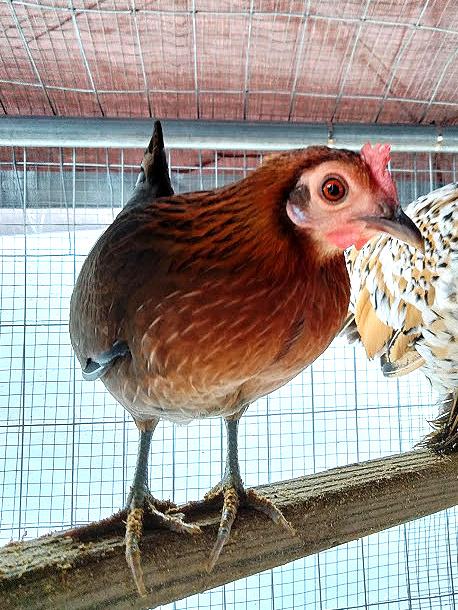
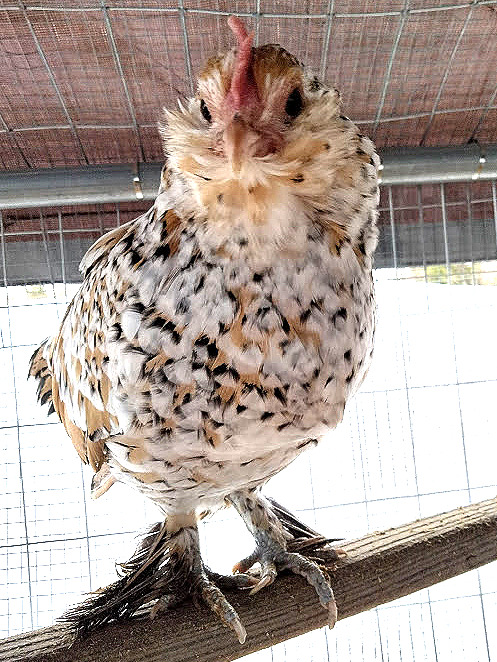
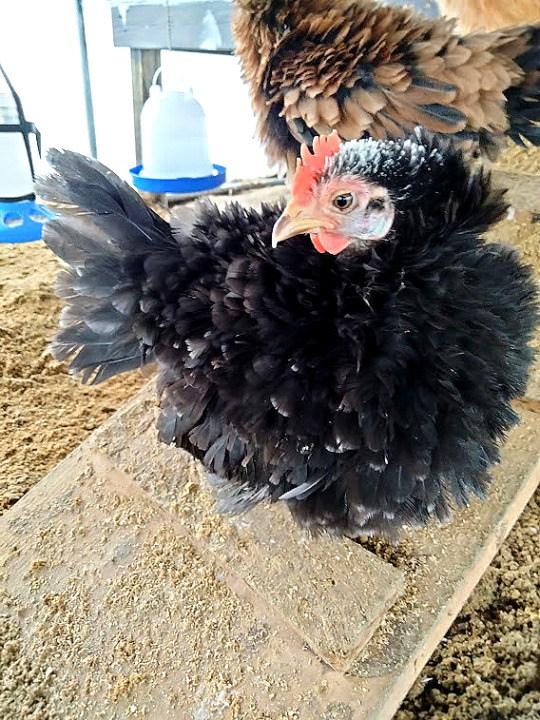
So many pretty ladies!
#chicken#pet#poultry#bantam#oegb#old english game bantam#sebright#white face black spanish bantam#cochin#d'Uccle#serama#frizzle
13 notes
·
View notes
Text


Bloodstained 🩸
(Painting vampires with cochineal red will never get old tbh)
297 notes
·
View notes
Text
In my research today I found this textile fragment in the Met Museum's collections:
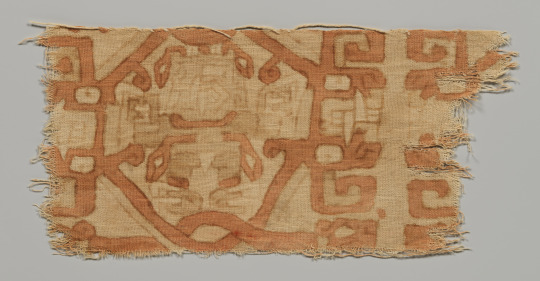
Interesting things about it:
It's coloured with iron earth pigments
It's made of cotton
It's from Peru
From the THIRD OR FOURTH CENTURY BCE
This so shook my expectations of what-where-when that I fell down a rabbit hole and discovered that
Cotton was independently domesticated in the Old World (Asia and Africa) and New World (South and Central America) long before the Columbian Exchange, and
The variety of cotton currently marketed as "Egyptian Cotton" (Gossypium barbadense) is generally grown in Egypt, but it's a cultivar that was developed roughly three thousand years ago in SOUTH AMERICA. Like... Ecuador-region.
(The cotton that originated around Egypt, Gossypium herbaceum, is a perennial shrub that still grows wild, but has largely been replaced by New World varieties for commercial purposes.)
I forget if I posted before about how amazing pre-Columbian lace in South America was? You may not know: I fucking love lace. And that's just part of it. I found a really cool online museum exhibit from Peru that gives a quick overview of how huge the field is.
I found all of this as a side-tangent from cochineal (itself a whole tangent from Slavic folk embroidery), because the world is so enormous and splendid and complicated. Currently debating whether or not to spend an audiobook credit on A Perfect Red by Amy Butler Greenfield.
1K notes
·
View notes
Note
I'm sure you've covered the bug situation at some point, but just because I'm curious and to ask more specific questions: what are the biggest insects one could ostensibly find? Are any insects kept like bees (are there just bees)? Any sort of cultural significance involved with insects?
The bug situation is pretty much earthlike, you aren't going to be able to find any insects bigger than can be found in the cenozoic.
There ARE indeed just bees, they haven't been mentioned a lot since most of my posting is based around Whitecalf's setting and beekeeping isn't heavily practiced in Imperial Wardin (the Hill Tribes are the only people in the region that beekeep as a core cultural practice, and their migrant progenitors May have brought the region's first domesticated honeybees with them) but beekeeping is very widespread. Silkworms are also canon.
The kermes insect and cochineal is canon, and species of both can be found in Imperial Wardin (the cochineal here is closest to the armenian cochineal specifically). Both produce a high quality red dye, though smaller quantities of cochineal are required to make the same amount of dye. A cochineal more akin to the Central American species (feeds on cacti) is found west and south across the seaway, (including parts of Bur), and is the most valued of all (has the highest dye output).
Some of the purely invented kept insects include:
Caviar ants, which are a type of domesticated leafcutter that has been selected for multi-queen colonies and massive egg production. Their eggs and larvae are a STAPLE food in a lot of qilik societies- qilik are primarily carnivorous (specifically insectivorous) and can digest a limited range of plant matter- this is a form of mass agriculture that most readily and cheaply feeds large populations. Caelin and delkhin societies also utilize them (though tend to depend more heavily on large animal agriculture), and some human/elowey societies have adopted them (though virtually never as a staple food).
Silk-orchard spiders, which are a species of colonial spider that can be reared for mass silk production with a stable enough food source. This silk is much costlier to produce than that of silkworms, but MUCH stronger, and is used to make ultra-lightweight armor (it's not going to stop a direct stab of a blade in of itself, but can be highly viable when padded and reinforced).
King locusts, which are domesticated grasshoppers selected to be big (about the length of a human hand), fat, slow, and flightless, and reared as tiny livestock (mostly by qilik).
Two decorative arthropods that are used in the Cynozepal/Ch'Chen regions primarily, which are brooch beetles (a mix of selectively bred and wild-caught beetles worn live as jewelry) and jewel ticks (colorful ticks that rarely transmit diseases to non-mammalian hosts, intentionally allowed to latch as temporary decoration).
(This old post goes into most of these in further detail ft actual illustrations here [x])
---
I don't have Many specific culturally significant insects established but here's what I've got so far:
-One deity in the Burri pantheon is the god of beekeeping (as well as a minor agricultural deity).
-Insects are VERY significant to the Chit-Sut-Susit qilik culture. Most in this group have converted to the Cynozepali Cosmic Dualist religion and do not worship their original gods (the chief of which was strongly associated with butterflies) but retain practices of ancestor worship. One facet of this is believing that each person has two souls, one that remains earthbound after death to guide the living, and one that moves on to the afterlife. Earthbound souls of ancestors take the forms of moths and butterflies, and these animals have a protected and sacred status. Butterflies in particular are associated with masculine beauty (which is primarily being delicate and colorful) and the garb of Chit-Sut-Susit drakes often mimics butterfly patterns.
-The periodical cicada is a symbol of esoteric knowledge and enlightenment in the (pretty major) Eterhimhamdli religion, which is the dominant religious practice east of the Blackmane mountains across many cultural groups (and is a religious minority in Imperial Wardin, mostly brought by Yuroma migrants). This religion's core doctrine recognizes no deities and no individual soul (rather believes that personal experience is a facet of a collective consciousness/oversoul) and the primary goal of its priesthood is accessing hidden knowledge obtained by freeing the mind from the body (through meditation, trance, psychoactive drugs, and trepanation) to tap into the oversoul, and achieving enlightenment through completely freeing oneself of the body's illusions and attaining full experience of the oversoul. The cicada's cycle of 'sleeping' beneath the earth for years, then emerging as one in unison is used as an analogue for enlightenment and the return to the collective. (The Scholarly Order of the Root is a sect of this religion)
-Horseflies are admired by the Tho-Tykoso people (north of the Viper seaway, adjacently north of the central Royal Dain kingdoms). They are noted for being small yet difficult to kill due to their agility, and capable of inflicting great pain and wearing down much larger beasts. Their warrior culture is based mostly around mounted archery using small, nimble khait, and they seek to emulate these qualities. Horsefly symbols are common on khait tack and the clothing of warriors.
55 notes
·
View notes
Text
OFMD Season 2 'missing scene' fic list
A compilation of Ed and Stede fics set during season 2, organized (roughly) by the episode they start in/after
big thank you to every single (brilliant, amazing) author who has ever written an ofmd fic, and also to the AO3 tab I've had open since november filtering for this sort of thing
post-canon fic recs
list under the cut!
2.1 impossible birds
Further Grievances Below- ElapsedSpiral, 5k
Pearls- cochineal, 3k
2.2 red flags
Finally- Fyre, 700
Purgatorio- endofadream, 2k
Pink- saltlick, 1.5k
I hate you for what you did and I miss you like a little kid- ineffableteach, 1.5
2.3 the innkeeper
Somniphobia- YellowMustard, 10k
Drifting- Chocolatepot, 1k
I loved my friend- Dialects_and_Costumes, 1.5k
2.4 fun and games
You Made It Home with Silver String Unbroken- veeagainst, 13k
Seabird- celluloidbroomcloset, 2.5k
Thought We'd Find Salvation (at the bottom of a glass)- Pamplemousse, 6k
Place Names- notfromcold, 1k
I knew a monkey once- Steve Bonnet, 8k
The Right Vibe- Fyre, 3k
Amends- prepare4trouble, 6k
delicate (ed's version)- insidethevoid, 6k
Security- Fyre, 1.5k
Ed gets some TLC after s2e4- pirate_captains_captain_pirates, 1k
Ed scared of accepting help- pirate_captains_captain_pirates, 1k
Ed worried the crew will want revenge- pirate_captains_captain_pirates, 1k
2.5 the curse of the seafaring life
A Gentleman’s Handy- Fyre, 3k
The Kissing Game- veeagainst, 8k
The Green Flash- triedunture, 5k
Whim-Prone- celluloidbroomcloset, 1.5k
Family- pirate_captains_captain_pirates, 2.5k
Fingerposts- westernredcedar, 7k
Quiet- Fyre, 1.5k
Sackcloths, Hugs, and a Warm Bath- pirate_captains_captain_pirates, 3k
Delicious- BookknobsandBroomsticks, 2k
Stede promising Ed he's cute- pirate_captains_captain_pirates, 1k
Ed talks with Lucius- pirate_captains_captain_pirates, 1k
2.6 calypso’s birthday
A Time for Change- aveotardis, 2k
Slow Dancing- gothicginger, 500
*****
Just Fireworks- Living_City, 4k
my sanctuary (you're holy to me)- endofadream, 9k
Press me to your heart- artismysanity, 5.5k
Losing count- bizarrelittlemew, 3k
Like a Virgin- darkshrimpemotions, 1k
To stop you bleeding- Ammy, 5k
Man on Fire- celluloidbroomcloset, 700
How a Fate Can Change- Followsthebees, 10k
More of You- deedeeinfj, 3k
2.7 man on fire
A Slice of Happiness- demolitionwoman, 2k
A Very Simple Man- This_Will_Be_Our_Year, 3k
Bright & early- summerlinenss
2.8 mermen
Tenderly the light- darcylindbergh, 5k
Me and My Boyfriend- CobaltAugust, 1k
in the dark and out of harm- foxtails, 2k
Interlude- ferventrabbit, 2k
*****
Rewards in this life- unfolded73, 5k
As we go hand in hand- artismysanity, 700
I Got Your Letter- Timonger, 700
I know, i know- karawrites, 800
All The Things We Should Have Said- CommunionNimrod, 3k
A moment of silence- philadelea, 1k
Some Things Old, Some Things New- Bornonabeach, 5k
Packing Priorities- quiet_compassion, 1k
135 notes
·
View notes
Text

I wasn't going to talk about this, [because it's sad] but I think it will come up anyway for the sake of transparency and my Ko-fi.
I have chickens. We've had them for several years. We don't eat them, they all have names. They just roam the property during the day and eat the lawn down and give us eggs. Two years ago we lost half our flock because someones bastard dog entered our yard and just... slaughtered them. Ran them down for fun and killed ten of our hens. Our roosters fought back because that's their job. Rooster spurs function like raptor claws and they will jump kick anything they don't like. One of our roosters barely survived the attack. He lost a tennis ball sized hunk of flesh from his rear and back and was recovering in the house for months. He's a fully black, part Cochin named Tipsy. Our calmest quietest boy.
The day before yesterday something attacked our flock again. The neighbors [who all have dogs] say they've been seeing coyotes. We had six roosters to protect the flock. Tipsy is the only one who survived. This time with lost feathers but no bites. Pictured is our original alpha Whisper. He died in the coop, likely protecting the others. We lost several girls; Cookie, Sarah, Dominique. I'm still trying to take stock. They killed Songbird, Robin, Yang and Red. The reminder is a dozen hens plus Tipsy. Lie is devastated. She cried all day and through her shift. So I did something impulsive that I really couldn't afford for her sake. I ordered some chicks. They're usually between $3-6 each when they're only a day old. I got six females. Nothing special or expensive. And they threw in a free one which will almost certainly be a rooster of some random breed. Just to give Tipsy a second in command. So in about three weeks I will likely have chick pictures to share and that will be the reason. I hate seeing my love so sad. And we've bowed out on getting chicks the last two springs because of money or time issues. Now I just need to clear out the storage space for the pen and set up the lights and junk again.
Also someone sent me a pair of trailcams and I don't know who it was. Thank you. ;_; So if I get any good ghost or animal photos you'll get to see those too. We're just recovering here.
42 notes
·
View notes
Text





On February 6th 1685 Charles II the “merry monarch” died.
The following is an account of King Charles II death by his physician Charles Scarborough, it seems quite horrific, and given a choice I think I would prefer to have died the same way as his old man, with one swift chop of the axe!
When Charles II lay dying from a convulsion which attacked him while shaving, the medicos of that day left no stone unturned in helping him along to the Great Beyond. First, he was bled of a pint of blood. Then his shoulder was cut and eight ounces more of blood was extracted by cupping.
Then followed an emetic, a purgative and another purgative. Next, an enema in which they used antimony, sacred bitters, rock salt, mallow leaves, violet, beet root, camomile flowers, fennel seed, linseed, cinnamon, cardamom seed, saffron, cochineal and aloes. This enema was repeated. In two hours, another purgative was given.
The King’s scalp was then shaved, and a blister raised on it. They gave him next sneezing powder of hellebore root; they sought to strengthen his brain by giving him powder of cowslip flowers. Purgatives were frequently repeated. He was given drinks of barley water, licorice, sweet almonds, white wine, absinthe, anise seed, extracts of thistles, rue, mint and angelica. When these did not cure him, they gave him a poultice of burgundy pitch and pigeon dung, to be applied to his feet. More bleeding, more purging; they added melon seeds, manna, slippery elm, black cherry water, extracts of flower of lime, lily of the valley, peony, lavender and dissolved pearls. When these did not do the trick, they went at it with gentian root, nutmeg, quinine and cloves. When this failed, he was given forty drops of extract of human skull. Then they forced down his throat a rallying dose of herbs and animal extracts. Then some powdered bezoar stone.
Alas, after an ill fated night His Serene Majesty was so exhausted that all the physicians became despondent. And so, more active cordials, and finally pearl julep [a heart tonic] and ammonia, were forced down the royal patient’s throat. Then he died.
Charles II died aged fifty-five, he suffered an apoplectic fit while shaving. He died four days later but may well have survived without the medical intervention of the day. No shir!
27 notes
·
View notes
Text

Here's a little "today I learned" about Hiraga Gennai 平賀 源内, arguably one of the most interesting individuals of the Edo period.
+ Gennai was born in 1729 in Shidoura village, Sanuki province (one of the provinces on the Nankaido road) as the third son of Shiraishi Mozaemon, a low-ranking samurai.
+ He grew up in a family with many siblings and was a precocious, intelligent child whose interests ranged from painting to poetry, and science to naturalism. In fact, pretty much the only thing I didn't find in references was any mention of talent with (or even just interest in) the sword.
+ Around age 12 or 13, Gennai became an apprentice of one of the domain's doctors where he learned traditional Japanese medicine, herbalism, and Confucianism.
+ After his father died in 1748, 19-year-old Gennai became the head of his family. During the Edo period, it would have been more common for the eldest son to succeed the father as both head of household and in his hereditary post (if he held one), so it stands to reason that Gennai's two elder brothers either did not survive into adulthood or there was some other reason neither could succeed their father.
+ Around 1752, Gennai traveled to Nagasaki to further his studies. Specifically, he studied rangaku (Dutch learning, but really any Western learning): Western medicine in general, surgery specifically, natural sciences, and oil painting, for good measure.
+ After his time in Nagasaki, Gennai realized he was much more interested in studying, traveling, writing, and inventing than he was in being heir to his family or being stuck in his province. He abandoned his position as head of the family - this went to his sister's husband - and resigned from his clan, becoming a ronin, so he would be free to pursue his own interests.
+ Gennai was interested in everything. At various times, he pursued (among many other things, I'm sure): Western medicine, surgery, traditional Japanese medicine, herbalism, mining and smelting techniques, mining development, natural history, ferry building, electric generators, fire-proof cloth, pottery, plays, and literature.
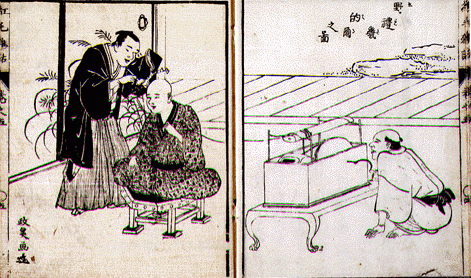
Electricity go brrrrrrr: Gennai obtained a broken, second-hand elekiter (エレキテル) from a shop in Nagasaki in 1770 and used it as the basis to build his own. He demonstrated the elekiter to the shogunate and many individual daimyo, and used it to treat various medical conditions, though perhaps more as a novelty than a legitimate attempt at treatment.

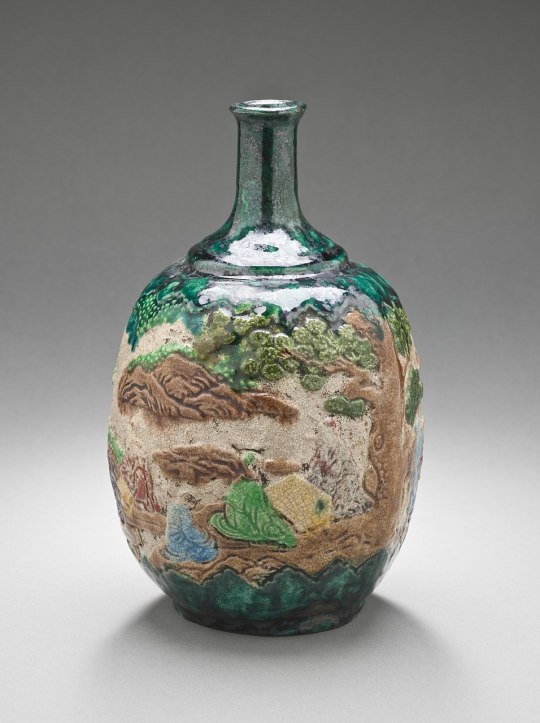
Two more things from the brain of Hiraga Gennai:
On the left, kakanpu, Gennai's fireproof cloth woven from asbestos, which would obviously not burn even if you threw it directly into the flames; and on the right, green glaze pottery dubbed Gennai ware, which was based on Chinese cochin ware.
Gennai also wrote ... a lot. He published 6 illustrated volumes on herbalism, 5 kabuki plays, 9 gidayu, and an assortment of other works, including an essay on farting, a guide to kagema of Japan, and his most popular work, Rootless Weeds, a gay love story featuring Enma, the king of the underworld, and Gennai's lover, the onnagata Segawa Kikunojo II.
That's Kikunojo in the two prints below. Yes, he's a man, despite appearances.
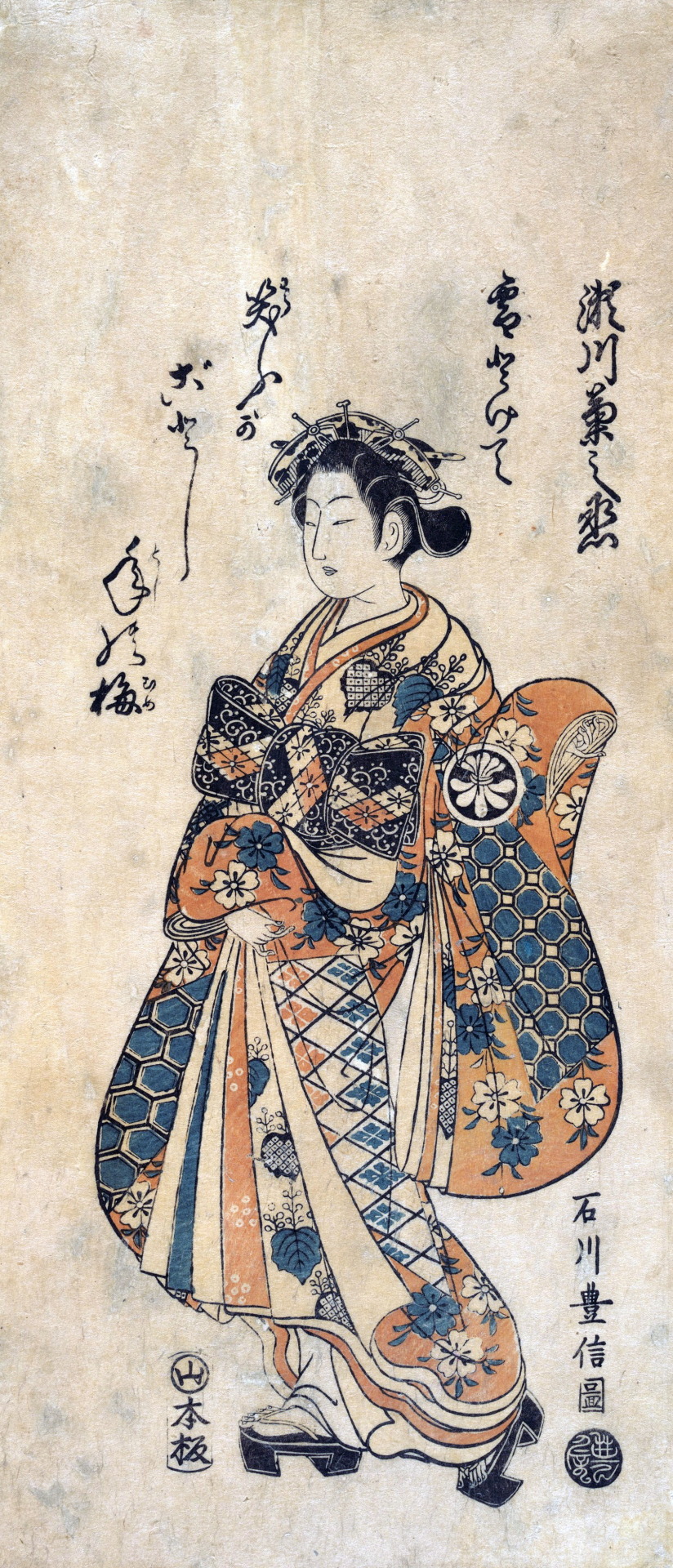
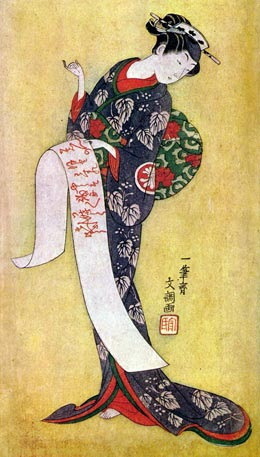
+ Gennai's death is a bit of a mystery. Apparently, he was involved in the building or renovation of a daimyo's mansion. At some point in this process, a drunk Gennai started arguing with several of the carpenters over what he believed to be stolen plans to the mansion. The argument turned violent and Gennai murdered at least one man and perhaps killed or injured a second.
+ He was arrested and died on 24 January 1780 in prison. His cause of death, unexpectedly, seems to have been tetanus.
#hiraga gennai#til#today I learned#edo period#history notes#historical notes#history reference#historical reference#history research#historical research
104 notes
·
View notes
Text
Comment if your favorite isn’t up there
39 notes
·
View notes
Text
Backyard Chickens: A Master Post
So you want your own little dinosaurs to eat your table scraps and make breakfast for you in the sunny months. Well! I am here to provide a quick starter to getting your own flock set up - and yes, for urban chickens as well.
Things to consider:
What can you have? Local laws usually dictate how many chickens can be kept per household/acre. Laws can vary by state and city. Look this up first. You can usually keep more bantams (miniature chickens) than their full-size cousins, and with chickens being so social I do recommend bantams for urban/suburban yards.
What weather will they be exposed to? Indoor chickens can generate a lot of dust, but small outdoor coops can be difficult to heat safely. Dual purpose breeds are usually more cold-hardy than layer varieties, and everybody likes fresh water and shade in the heat. Frozen water bottles left outside to thaw can keep birds cool, too.
What will eat them? I have had little losses to foxes, personally, and more to neighborhood dogs. Raccoons are nearly everywhere in North America and will tear open fences to eat your babies. (I would know. I've had to deal with the aftermath.) Rabbit hutches are a good starter for bantams, but a good coop made of wood and a yard made of hardware cloth or dog fence panels (and with netting on top for hawks/owls) will keep out most things. Weasels/mink will fit through gaps bigger than an inch, so be careful of that, too.
What do they need? Chickens love to scratch and forage (and some can fly short distances and modest heights) so if you're letting them on the lawn be prepared for them to eat it - no pesticides on that turf! At night, they prefer to sleep on perches/something with a bit of height to it and do best locked in their coop where other critters can't eat them. A place to nest and lay their eggs in their coop (otherwise they will find their own little secret place, God help you find it) and a place to dust-bathe (like chinchillas) to help keep mites and lice out of their feathers. They'll also need some grit and calcium - crushed oyster shell (or their own eggshells) will help.
Where can I get them? Many farm and feed stores like Tractor Supply Company will sell baby chicks during the spring, but if you're looking for specific bantams or unusual breeds I recommend checking out your State Fair or a Poultry Association show [American version located here] and check it out. They're free admission, generally, and almost every show has people who bring birds to sell. While the demographics tend to slant pretty "red" I have seen plenty of blue hair and pronouns at poultry shows. Facebook can also be a great resource.
How do I get everyone to get along? Chickens are notoriously territorial, with a vicious pecking order that make Mean Girls a documentary. Chickens who are raised from chicks together will get along best, but if you need to add more I would introduce two or more at a time (so the newbies have a friend) and put them in a nearby yard/cage for a few days until everyone has worked out their opinions through the bars of a cage. Some breeds are sweeter than others (buff orpington) and some are.... spicy (Plymouth rocks).
Saro's Personal Breed Recommendations
Dual Purpose (cold weather) - Black Australorps , Buff Orpington, New Hampshire Reds are all generally pretty good natured and calm. The platonic ideal of a chicken.
Layer breeds (warm weather) - Leghorns are the go-to, but I have a soft spot for Hamburg as well. And of course, who wouldn't love a chicken who lays dark brown (Marans) or green/blue (Ameraucauna) eggs?
Bantams - D'Anvers with their little beards are my all time favorite and have the biggest personalities in my experience, but Old English Game (even more zippity) and Black Sumatras (all black, even down to the skin, and shockingly calm in hand) are high on the list as well. And everyone loves the fluffy-faced Silkie or feather footed Cochin.
Hopefully this is enough to get you started! Feel free to send me questions or add on with a couple of your own tips (especially non-US people and those with indoor chickens). I've been raising them for eggs, pets, and for show since 2005, but I am always eager to learn.
63 notes
·
View notes
Text
OC Recipe Tag
Thanks for tagging me, @sam-glade, @autumnalwalker, and @tabswrites! :D
Rules: share a recipe your OC would make, either one passed down to them or one they found all by themselves. Bonus if you have an actual recipe to link! Some OCs can't cook to save their lives, but let's talk about the ones who can! :D
Still using this old cookbook, and here's Thomas's favourite food in Uneasy Money!
PEARS, Baked. Ingredients.—12 pears, the rind of 1 lemon, 6 cloves, 10 whole allspice; to every pint of water allow ½ lb. of loaf sugar. Mode.—Pare and cut the pears into halves, and, should they be very large, into quarters; leave the stalks on, and carefully remove the cores. Place them in a clean baking-jar, with a closely-fitting lid; add to them the lemon-rind cut in strips, the juice of ½ lemon, the cloves, pounded allspice, and sufficient water just to cover the whole, with sugar in the above proportion. Cover the jar down closely, put it into a very cool oven, and bake the pears from 5 to 6 hours, but be very careful that the oven is not too hot. To improve the colour of the fruit, a few drops of prepared cochineal may be added; but this will not be found necessary, if the pears are very gently baked. (What is cochineal, you ask? According to Wikipedia it's carmine food colouring... derived from insects.) Time.—Large pears, 5 to 6 hours, in a very slow oven. Average cost, 1d. to 2d. each. (1-2 pence, but nowadays this would be more like £10-£12.) Sufficient for 7 or 8 persons. Seasonable from September to January.
Tagging @sleepyowlwrites, @mrbexwrites, @iamwritehere, and anyone else who wants to do this! :D
9 notes
·
View notes
Video
youtube
https://www.youtube.com/watch?v=xEL-NKosKG0
Often, when you hear music from the Cochin Jewish community originally of Kerala, India*, you’re hearing a recording of songs sung by women in Malayalam that celebrate various life-cycle and religious events but aren’t actually part of the liturgy. This actually is Cochin liturgy. It’s a recording of a special Yom Kippur melody for the Kaddish. There’s something very deliberate about this performance that I find highly compelling.
*Most of them up and moved to Israel. There are a few very old Jews left in Cochin, but most of the community members were quite excited when Israel became a country and couldn’t wait to move.
8 notes
·
View notes
Text


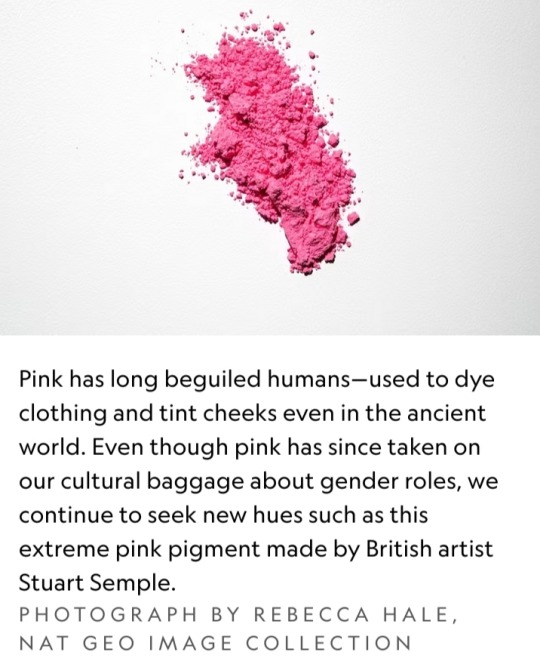
Could pink be Earth’s oldest color? That’s the implication of a 2018 study that found bright-pink pigments in 1.1 billion-year-old rocks — thanks to the fossils of the billions of tiny cyanobacteria that once dominated oceans.
The natural world has long been painted with every permutation of pink — whether embedded deep in ancient rock, sported by shrimp-hungry flamingoes, or simply lining the shores of Bermuda’s pink-sand beaches.
And yet the color carries a lot of cultural baggage.
As pink made the jump from nature’s palette to human adornment, it gathered connotations of colonialism, beauty, power, and gender.
How did pink become such a cultural flashpoint? As the world takes a revitalized interest in the hot-pink planet inhabited by Barbie, here’s a short history of the compelling color.
Admiration for pink in the ancient world
Early humans quickly transitioned from admiring pink in the natural world to attempting to wear it.
For example, in the Andes Mountains about 9,000 years ago, fierce hunters in what is now Peru wore tailored leather clothing with a pink hue thanks to red ochre, an iron oxide pigment that is one of the oldest natural pigments used by humans.
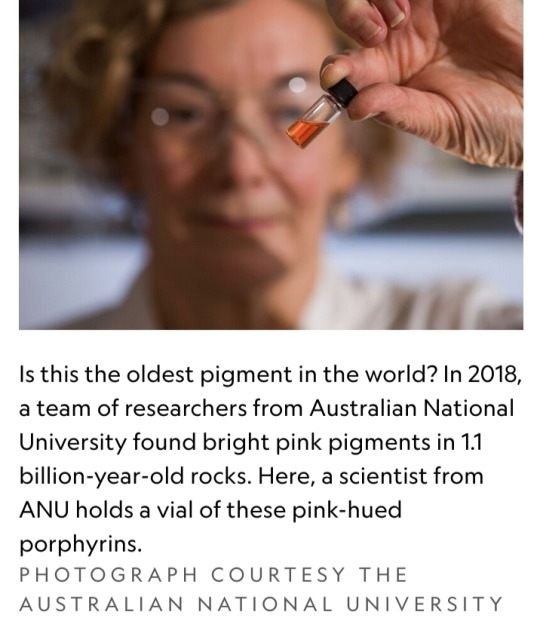
Humans weren’t content just to smear this pigment on cave walls or use it while tanning their leather garments.
As far back as ancient Egypt, humans used ochre to tint their lips and cheeks.
When applied to human skin, the red pigment created a blush-like pink that onlookers associated with love, sexuality, and beauty.
Lookalike concoctions prevailed around the world, employing everything from crushed strawberries to red amaranth.
The color of cosmetics—and colonialism
Though the word’s etymology is unknown, the word “pink” was used to describe the color in the 18th century.
By then, pink had become inextricably tied with colonialism — as demand for the pigment for cosmetics drove Europeans to harvest natural resources in other parts of the world.
For example, in a bid to make pinkish pigments from the bark and red sap of brazilwood trees, European traders forced enslaved workers to cut down so many of Brazil’s eponymous trees that the country was left deforested and the tree nearly driven extinct.
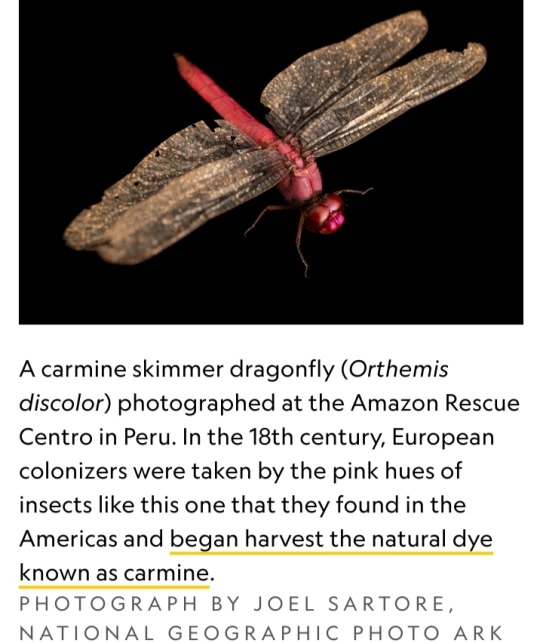
During this Era of Exploration, consumers also got their pink cheeks and lips from other pigments like carmine, derived from cochineal insects harvested in Central and South America under similar conditions.
Meanwhile, the color also had a more literal association with colonialism:
During this time, the British Empire grew so massive that the color pink — which mapmakers used to mark its territories worldwide — dominated the world map.
Pink becomes a bona fide fashion craze
As red tints became more accessible and cheaper, 18th-century European aristocrats indulged a passion for pink.
Art historian Michel Pastoureau writes that “the most privileged classes of European society wanted pastels, halftones, and the newest innovations in color shades in order to distinguish themselves from the middle classes, who now had access to bright, strong, and reliable colors.”
Madame de Pompadour, the mistress of Louis XV of France during the 1740s and 1750s, used the color as a signature.
The artists who painted her and created fine objects for her many homes used pink in all their designs, even her carriages, and she helped further popularize the hue throughout Europe.
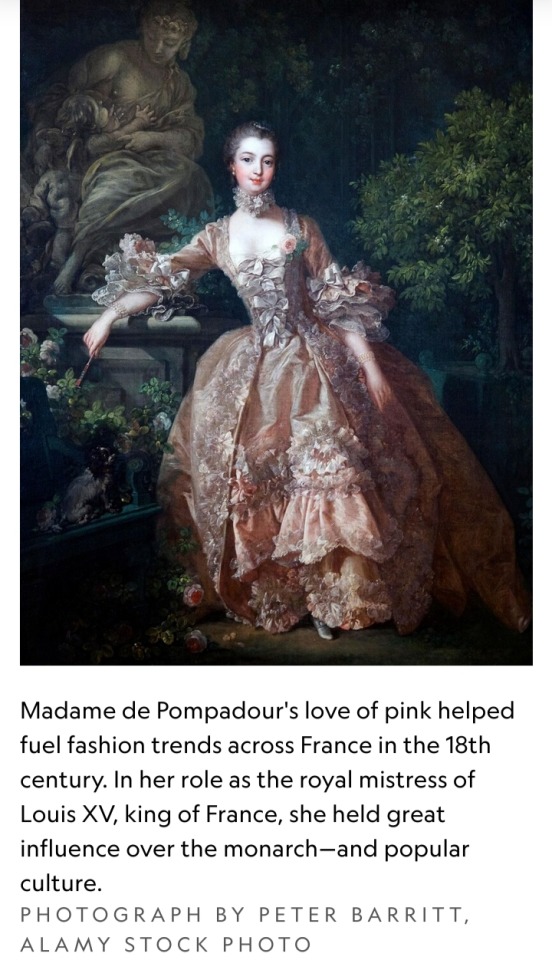
The emergence of synthetic dyes in the mid-19th century — which gave rise to the purple-pink color known as mauve — made pink more accessible than ever before.
By the 1930s, bright pink had become a bona fide fashion craze.
Avant-garde fashion designer Elsa Schiaparelli made “shocking pink” her signature color, helping spread the vogue for women’s wear.
It worked: By 1935, even local newspapers like the News and Observer in Raleigh, North Carolina, were declaring that “PINK IS FAVORITE.”
And in 1939, a royal commentator wrote in London’s Daily Telegraph that pink was so popular, it was nearly ubiquitous for both bridesmaids and debutantes.
“So general is the pink craze,” the paper wrote, “that some women are rebelling against it.”
Pink is for…boys?
Around the same time, pink gained relevance in another realm: baby fashion.
Gender and baby fashion had intersected for years; around World War I, etiquette guides and fashion advice columns began advising that mothers dress their children in clothing with gender-specific hues.
But which colors? A 1927 retailer survey on infant clothing colors published in TIME shows a split nation, with retailers like Filene’s and Marshall Field’s recommending pink for boys, but Macy’s, Bullock’s, and others claiming pink was best for girls.
By the 1960s, however, mothers began buying pink clothing for their female babies, dressing their male children in pastel blues.
“None of this transition happened by childcare expert fiat or industry proclamation,” writes historian Jo B. Paoletti.
Instead, pink gained steam as a signifier of a baby’s female sex as part of a post-World War II push to reinforce traditional gender roles in American homes — and the realization by retailers that they could make more money that way.

“The more baby clothing could be designed for an individual child — and sex was the easiest and most obvious way to distinguish babies — the harder it would be for parents to hand down clothing from one child to the next, and the more clothing they would have to buy as their family grew,” Paoletti writes.
Soon, retailers featured entire “pink aisles” packed with pink-colored clothing and toys for tiny consumers.
The dark side of pink
Pink was also rejected by some as a symbol of weakness or even sinister intent.
In Nazi Germany, for example, the color was used to brand gay men in concentration and death camps.
As the Cold War emerged, suspected Communist sympathizers were given the derogatory name of “pinkos” — a term that referred to a person with “red” tendencies toward radical politics.
Meanwhile, members of the women’s liberation movement attempted to distance themselves from a color that had become inextricably linked with femininity and sexuality — think: Marilyn Monroe slinking down a staircase in a shocking pink gown, surrounded by tuxedoed men.
Anti-feminists, meanwhile, embraced pink.
Author Helen B. Andelin, for example, made public appearances in all-pink ensembles in the 1960s and 1970s during lectures encouraging women to abandon feminism and embrace lives as housewives.
Reclaiming pink
Pink remains associated with femininity to this day — but in recent decades, groups once disdainfully branded with the color have made moves to reclaim it.
In the LGBTQ community, for example, people who were once forced to wear pink as outcasts have adopted the hue as a symbol of their movement for social justice.
In 1987, the AIDS Coalition to Unleash Power (ACT UP) adopted a bubble-gum pink triangle in its “Silence = Death” campaign to increase awareness of HIV-AIDS and destigmatize the disease.
It was just one example of pink being used to represent gay pride.
Some feminists have also reclaimed the color, fighting gender stereotypes with a tongue-in-cheek adoption of all shades of rose, fuchsia, and bubble-gum pink.
At the 2017 Women’s March, for example, a sea of protesters wearing pink, cat-eared “pussy hats” protested the inauguration of U.S. President Donald Trump, whose lewd remarks about female genitalia during a leaked interview drew worldwide condemnation.
Today, pink is what you make of it — and it has grown in popularity once more.
In 2016, Pantone announced that a shade of dusty pink — dubbed Millennial Pink for the generation that had embraced it—was its Color of the Year.

This year, Greta Gerwig’s upcoming Barbie movie helped fuel the rise of the pink-drenched “Barbiecore” aesthetic, inspiring admirers to saturate their homes and wardrobes with every shade of pink.
According to Axios, searches for the term “Barbiecore aesthetic room” rose over 1,000 percent between May 2022 and May 2023, reflecting consumers’ craving for as-pink-as-possible interiors.
There’s no telling which permutation of pink will captivate us next — but given the colorful history of the hues that fall somewhere between white and red, pink’s next heyday is probably right around the corner.
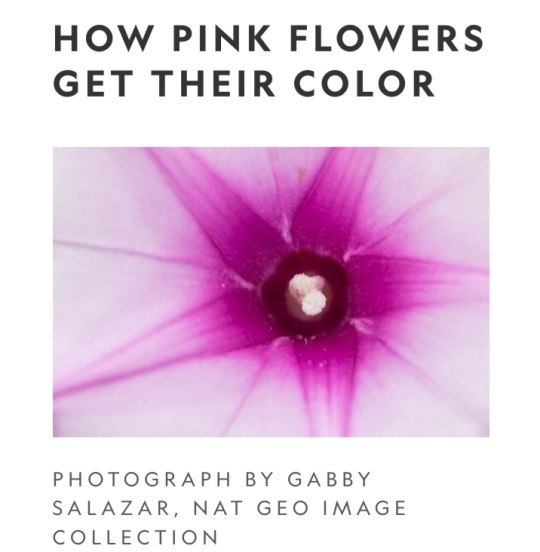
Barbie would approve of the pink petals on this beach morning glory.
Pink flowers like this one get their rosy tinge from a group of biological pigments called anthocyanins, which attract pollinators — and human admirers — to colors ranging from the palest carnation to the most ostentatious tropical fuchsia.
#pink#red ochre#carmine#Era of Exploration#Madame de Pompadour#Louis XV of France#mauve#Elsa Schiaparelli#gender#baby fashion#colors#Helen B. Andelin#AIDS Coalition to Unleash Power (ACT UP)#Pantone#Millennial Pink#Barbie#Nat Geo#fashion#political movement#Marilyn Monroe#Zsa Zsa Gabor#pigment
13 notes
·
View notes